Wood Splitter Tips and Tricks
- February 27, 2024
- 0 comment
When it comes to splitting wood, my journey has been nothing short of an adventure, filled with learning curves, makeshift repairs, and the sheer satisfaction of preparing for the cold seasons. My trusty wood splitter, a high-quality Chinese model purchased from Princess Auto in Canada (akin to the Harbor Freight for my friends in the U.S.), has been by my side for about 15 years. It’s one of those versatile stores where you find everything from cordless drills to pork rinds and, if you’re lucky, a wood splitter that becomes a part of your family.
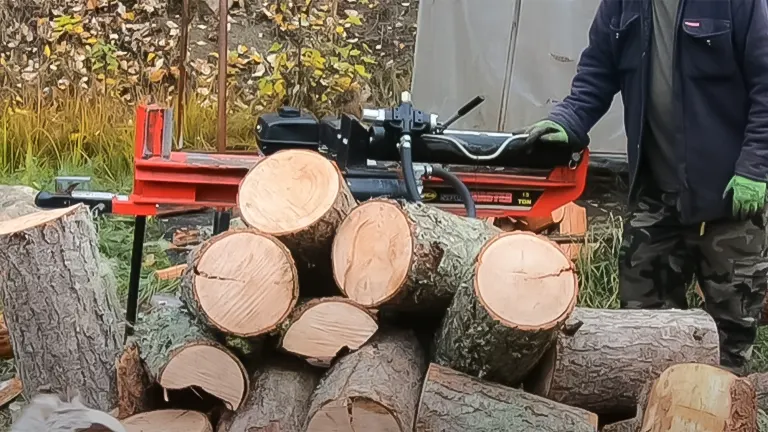
This wood splitter has seen me through approximately 50 cords of wood before encountering its first major hiccup. The malfunction, centered around the valve responsible for the ram’s in and out movement, significantly reduced the machine’s efficiency by almost 50%.
After a futile attempt to fix the original valve and the challenge of finding replacement parts, I opted for a new one from the same store. Though it looked identical, the functionality differed, particularly the auto shut-off feature, which meant more manual intervention and thus, more time per split.
List of Wood Splitter Tips and Tricks:
- The Art of Making Kindling
- Machine Throttle Management
- The Auto-Return Valve
- The Physicality of Splitting Wood
- Minimizing Labor Intensive Work
- Avoid Splitting Seasoned Logs
- Avoid Splitting Seasoned Logs
- Protection is Important
- Keep the Splitter Level
5 Steps for Wood Splitter Tips and Tricks
Despite this setback, the essence of wood splitting remains unchanged for me. It’s a process where simplicity meets efficiency, and even with technological hiccups, the joy and satisfaction derived from splitting wood endure. Here are some personal tips and tricks I’ve gleaned over the years:
Step 1: The Art of Making Kindling
Making kindling is a practical aspect of wood splitting, where logs without knots are targeted for easier splitting.
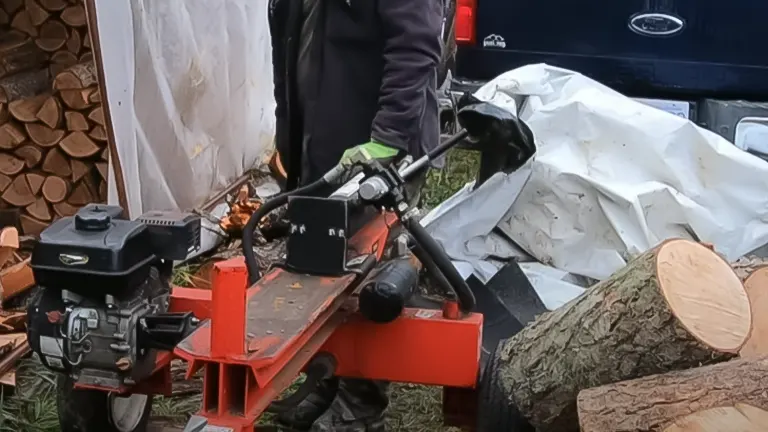
This process not only makes the splitting session more efficient but also ensures a ready supply of kindling for starting fires, aligning with the preparatory needs for efficient fire-building.
Step 2: Machine Throttle Management
Operating a wood splitter at full throttle is not always necessary and can be wasteful in terms of energy consumption and wear on the machine.
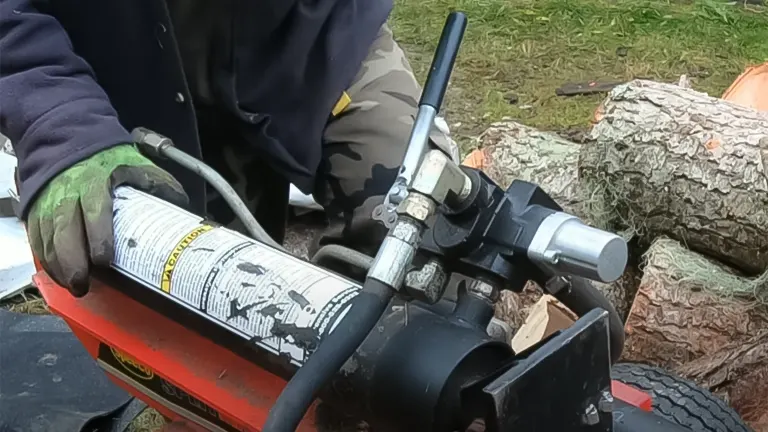
Using a moderate speed is effective for splitting wood while also helping to conserve fuel and extend the lifespan of the machinery, making it a smart practice for both maintenance and operation.
Step 3: The Auto-Return Valve
An auto-return valve is a significant feature for wood splitters, greatly enhancing productivity by reducing manual effort and time per cycle.
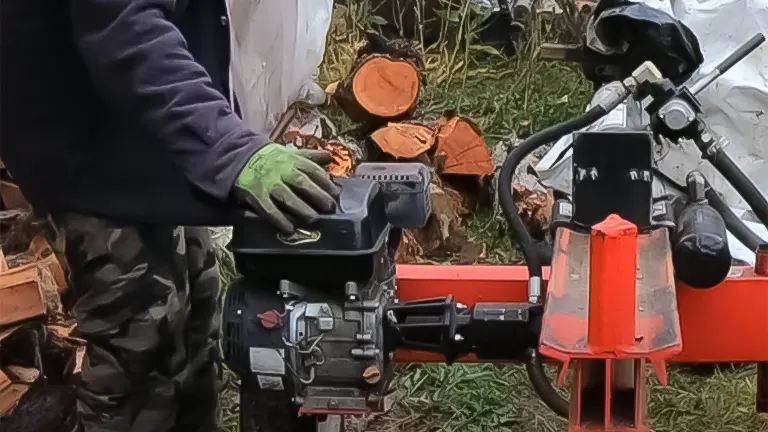
This feature allows the operator to multitask, preparing the next log while the splitter automatically retracts, thereby streamlining the splitting process and reducing overall labor time.
Step 4: The Physicality of Splitting Wood
Utilizing a wood splitter can greatly reduce the physical strain associated with manual wood splitting, particularly for older individuals or those with physical limitations.
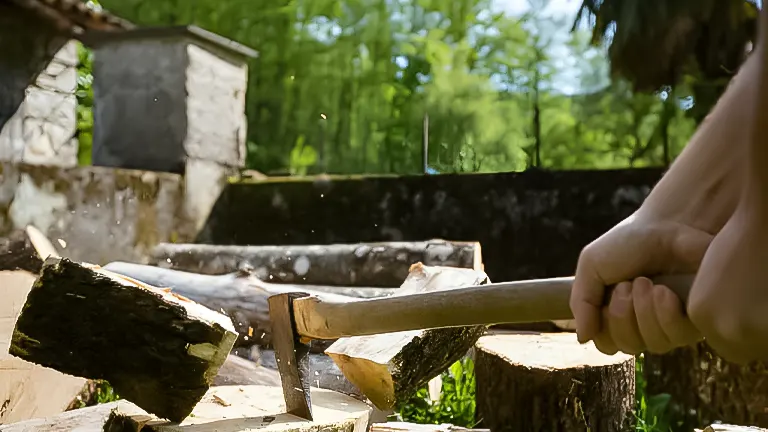
While manual splitting with an axe is a more physically demanding exercise that can offer health benefits, the efficiency and reduced physical strain provided by a wood splitter are invaluable for producing firewood with less effort.
Step 5: Minimizing Labor Intensive Work
In the firewood business, minimizing the labor involved in processing wood—from cutting in the forest to delivery to the customer—is crucial for efficiency and profitability.
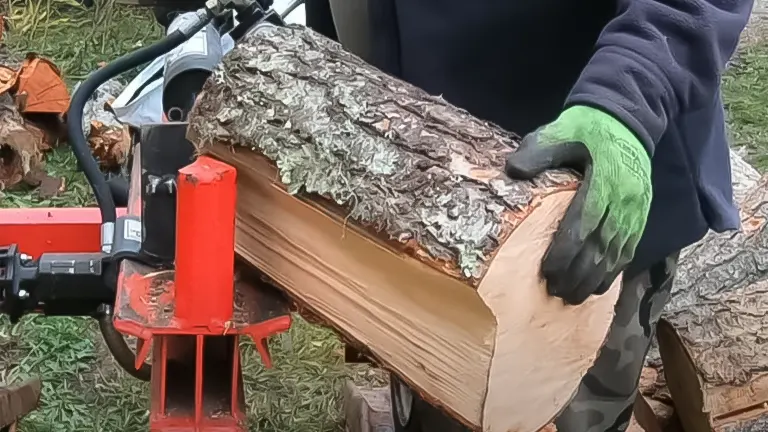
By reducing the number of times each log is handled, for example, through more streamlined processing steps, a business can significantly cut down on labor costs and time, enhancing productivity and profit margins.
Step 6: Avoid Splitting Seasoned Logs
Opt for splitting green logs over seasoned ones whenever possible. The inherent moisture in green logs facilitates a much easier split, contrasting sharply with the challenges posed by seasoned wood.
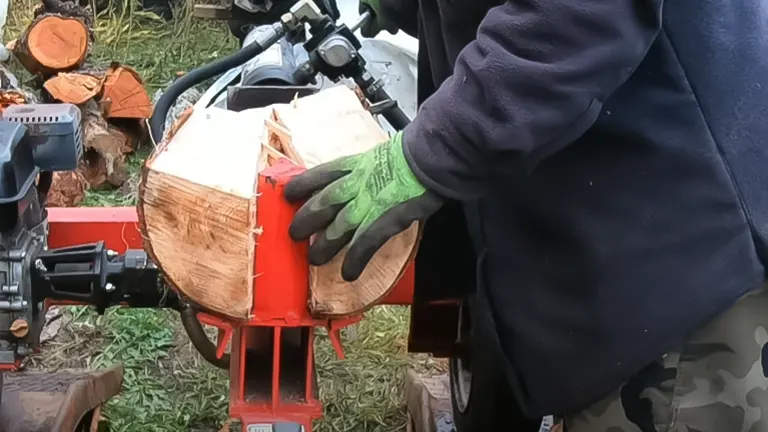
Seasoned logs, due to their hardened state, can unpredictably absorb the splitting force and release it abruptly, potentially causing the wood to shatter dangerously, akin to a “wooden splinter bomb.”
This unexpected release not only poses a significant safety risk but also hinders the splitting process. Additionally, green logs that are split and then allowed to season tend to dry more efficiently, speeding up the preparation time for use.
Step 7: Protection is Important
Wearing appropriate protective gear, especially gloves, cannot be overstated in its importance. Gloves serve as a critical barrier between your skin and the various hazards of splitting wood, such as sharp edges, splinters, and the mechanical parts of the splitter itself.
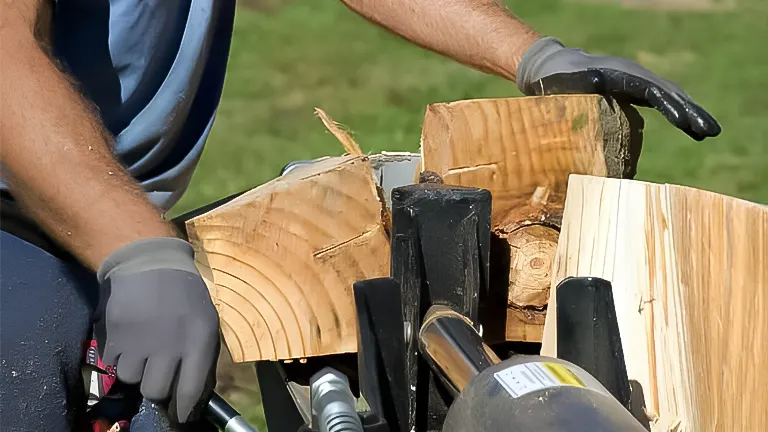
They enhance your grip, improve safety, and contribute to a more efficient and injury-free wood splitting session. Ignoring this simple yet effective safety measure can lead to unnecessary injuries that could easily be avoided with proper hand protection.
Step 8: Keep the Splitter Level
Maintaining a level position for your wood splitter is crucial for its effective operation. A splitter that isn’t level struggles with hydraulic oil flow, directly impacting its performance and efficiency.
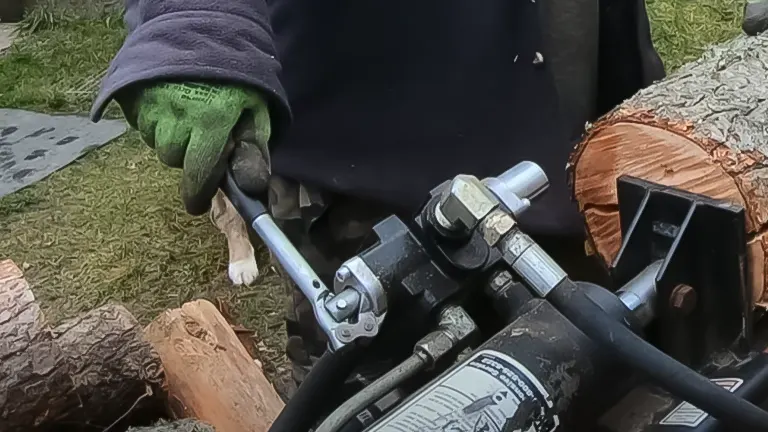
This misalignment can prevent the machine from applying consistent force, leading to incomplete splits or additional strain on the machine.
Ensuring your splitter is level is a fundamental aspect of preparation that significantly influences the ease and success of your wood splitting efforts, making it a priority for both safety and operational efficiency.
Additional Tips
- Regular Hydraulic System Checks: Inspect the hydraulic fluid levels before each use and look for any signs of leaks or damage to hydraulic lines. Ensuring your hydraulic system is in top condition is crucial for the efficient operation of your wood splitter. Changing the hydraulic fluid and filter as recommended by the manufacturer can prevent many common mechanical issues.
- Wedge and Blade Maintenance: Keep the splitting wedge or blade sharp and rust-free. A dull or rusty wedge can make splitting more difficult and potentially dangerous. Regularly inspecting and sharpening the wedge can make splitting easier and extend the lifespan of your machine.
- Clean and Lubricate Moving Parts: After each use, clean off any debris or wood chips from the machine, and lubricate all moving parts according to the manufacturer’s instructions. This prevents buildup that can hinder operation and helps to reduce wear on components.
- Use a Log Splitter Cover: When not in use, cover your wood splitter with a waterproof cover to protect it from the elements. Exposure to rain, snow, and extreme temperatures can cause rust and deterioration, which can lead to mechanical failures.
- Operate on Stable Ground: Always use the wood splitter on stable, flat ground to prevent tipping or uneven splitting force. If necessary, use shims or leveling tools to ensure the machine is perfectly level before starting your work. This not only aids in efficient operation but also minimizes the risk of accidents.
- Follow Manufacturer’s Loading Guidelines: Adhere strictly to the log size and weight limits specified by the manufacturer. Attempting to split logs that are too large or too heavy can strain the machine, potentially causing damage to the hydraulic system or other components. It can also increase the risk of jamming or projecting pieces, which could lead to injury.
Related Articles:
- Log Splitter Oil Change and Hydraulic Fluid Change
- Two Essential Log Splitter Modifications Every Owner Should Consider
- Best 3-Point Hitch Log Splitters
- Best Manual Log Splitters 2024
- Best Log Splitter for the Money 2024
- Wood Splitting Made Easy: The Tire Trick
Final Thoughts
In conclusion, my wood splitter, despite its quirks and occasional malfunctions, remains an indispensable tool in my wood splitting adventures. The journey has taught me the value of patience, the importance of equipment maintenance, and the art of efficiency. Whether you’re a seasoned splitter or a novice looking to dive into the world of wood splitting, remember that every log, every split, and every piece of kindling tells a story. And in this craft, the lessons learned and the satisfaction gained are worth every moment spent.
Frequently Asked Questions
- What is the best technique for making kindling with a wood splitter?
Focus on splitting logs without knots, as these will split more easily and uniformly, making them ideal for kindling. - How can I extend the life of my wood splitter?
Regular maintenance, including checking hydraulic fluids, sharpening the splitting wedge, and not running the machine at full throttle unnecessarily, will help prolong its lifespan. - What safety gear should I wear when using a wood splitter?
Always wear safety goggles, gloves, steel-toed boots, and ear protection to minimize the risk of injury. - Why is an auto-return valve important for a wood splitter?
An auto-return valve increases efficiency by automatically retracting the splitting ram after each split, allowing you to prepare the next log, saving time and effort. - Can I use a wood splitter on wet wood?
Yes, wood splitters can handle wet wood, but it may require more force to split, and the wood will need to dry before use as firewood. - What’s the best way to position logs for splitting?
Position logs upright and center them on the splitter’s wedge. For uneven logs, find the most stable orientation to avoid jams. - How often should I maintain my wood splitter?
Check the manufacturer’s guidelines, but typically, before and after the splitting season and after every 20 hours of use for routine maintenance. - What should I do if my wood splitter isn’t working efficiently?
Check for hydraulic fluid levels, inspect the wedge for dullness, and ensure all hydraulic lines are intact. Consider consulting the manual or a professional for troubleshooting. - Is it better to split wood when it’s fresh or seasoned?
Freshly cut wood can be easier to split because it’s less dense; however, splitting seasoned wood means it can be used sooner as firewood since it’s already partially dried. - How can I minimize labor when processing large quantities of wood?
Streamline the workflow by reducing the number of times each log is handled, use conveyors or carts for transporting logs, and consider a wood splitter with a higher capacity to handle larger logs and reduce splitting time.
We’re eager to hear from you! Share your personal experiences and insights on using wood splitters in the comments section below. Whether you’ve discovered a game-changing tip, have advice on maintenance, or want to share how a particular trick has made your wood splitting easier, your knowledge could greatly benefit fellow enthusiasts. Your contributions can help others make informed decisions and improve their wood splitting techniques!

Edward Smith
Forestry AuthorWoodworking is about more than crafting; it's a harmonious connection with nature, mastering tools, and preserving our environment. I'm here to share my knowledge and experiences with you, forging a future where we can embrace wood's beauty and utility while safeguarding our forests' health and diversity.













Leave your comment